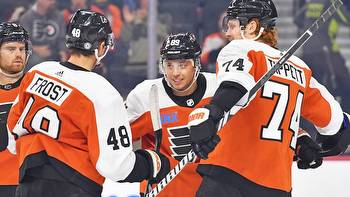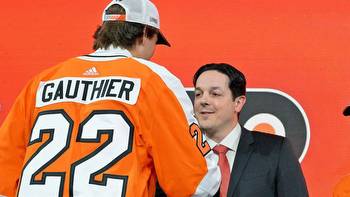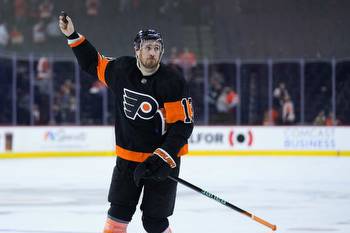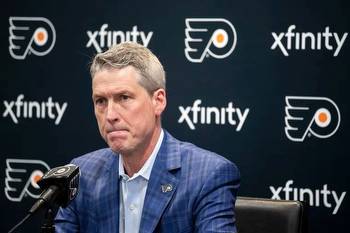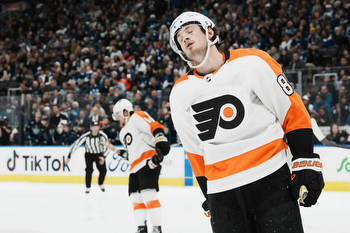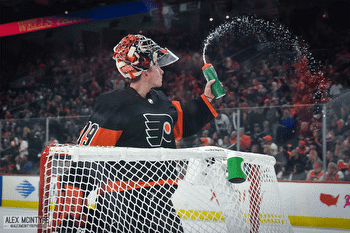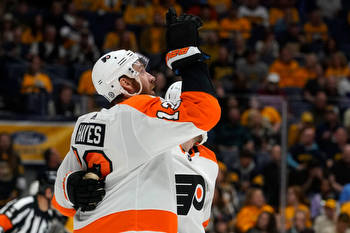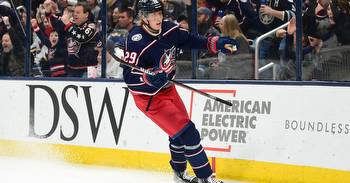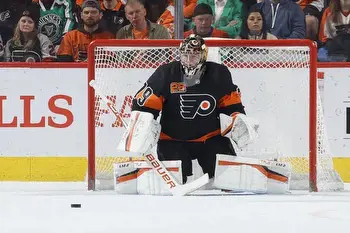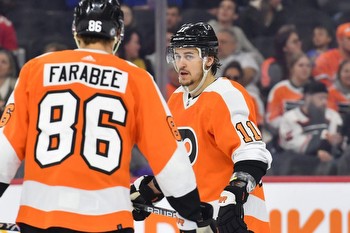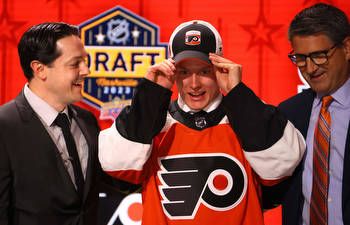Did the Flyers fix Rasmus Ristolainen? A look at his improvements and whether he can sustain them
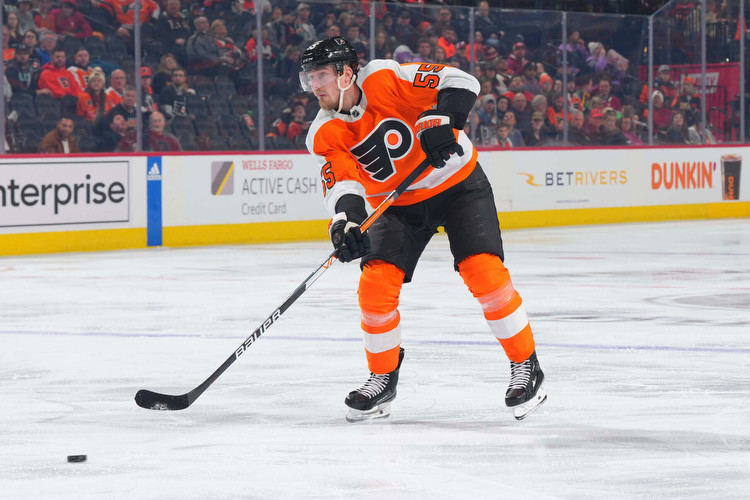
Through no fault of his own, Rasmus Ristolainen became something of a stand-in for fans’ frustration regarding the lack of organizational direction showcased by the Philadelphia Flyers in 2021 and (especially) 2022.
General manager Chuck Fletcher’s decision to trade a first-round pick and second-round pick (in addition to Robert Hägg) back in the summer of 2021 was certainly controversial; Ristolainen had long been a target of the public hockey analytics community’s ire, who were apoplectic regarding the NHL world’s high regard for him despite his consistently poor on-ice results. But at least during that summer, the Flyers had a viable case to still “go for it” in terms of trying to contend. Claude Giroux was still with the organization. Fletcher had already acquired Ryan Ellis that summer to help revamp the defense, and would soon swap Jakub Voracek for Cam Atkinson in another shake-it-up move. One could disagree with the decision to target Ristolainen specifically, while still believing the Flyers were justified in actively trying to “win now.”
That changed by March 2022.
The Flyers were in the midst of their second straight debacle of a season. Almost every highly touted young player on the roster had either stagnated or regressed. Head coach Alain Vigneault was gone. And the writing was on the wall for Giroux’s time in Philadelphia, as well. It was clearly time for the Flyers to look to the future, to accept the necessity of a rebuild — and to sell all of their rental players with value on the open market, such as Ristolainen, whose contract was set to expire in just a few months.
But that’s not what Fletcher and the Flyers did. Instead, just nine days before trading Giroux, they re-signed then-27-year-old Ristolainen — who was in the midst of yet another poor season by advanced metrics — to a massive five-year, $25.5 million contract extension, taking the blueliner well into his 30s. Instead of trying to recoup some of the assets they had spent to get him in the first place, Fletcher and the Flyers doubled down, confirming that they would not be rebuilding at all, even as they were poised to ship out their last player with any case to be considered truly high-end.
Since then, to the Flyers’ credit, they’ve accepted the reality of their situation, embracing a rebuild and moving out multiple players — Ivan Provorov, Kevin Hayes in particular — who no longer fit their contention timeline. But little talk surrounded Ristolainen, even as his regular partner (and fellow mid-to-late-20-something) Travis Sanheimnearly was moved as well. Why?
Perhaps Ristolainen’s contract is unmoveable; his most vocal critics would certainly argue that. Maybe the hiring of Keith Jones — a longtime Ristolainen backer — as president of hockey operations kept him off the chopping block. Or maybe, just maybe, it was something else. Maybe Rasmus Ristolainen actually took a significant step forward in 2022-23, and could be on the verge of no longer being deserving of the fierce criticism he still receives?
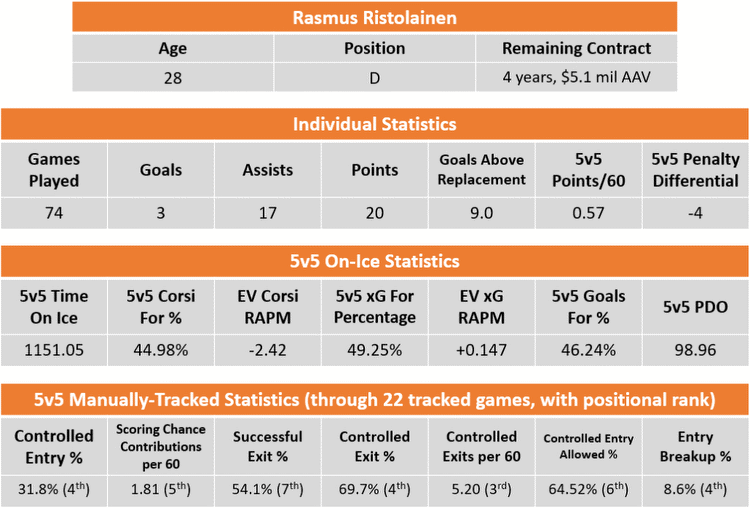
There was little reason to believe that the prevailing online narrative regarding Ristolainen was on the precipice of changing at the start of the 2022-23 season. In fact, it seemed like it was being fully validated.
Ristolainen missed the season’s first six games with a lower-body injury, returning for his season debut against Florida on Oct. 27. And he was bad. Really bad.
In fact, in those first four games, he was far worse than he had been at any time during his first season with the club — he was on the ice for five goals against and just one goal for across his 60 minutes of five-on-five ice time, also posting a ghastly 14.57 percent expected goals for percentage in the process. It was ugly.
So, new head coach John Tortorella scratched him — just four games into his shiny new contract. And Torts wasn’t particularly sympathetic to the idea that Ristolainen had simply returned too quickly from injury, or was just shaking off rust.
“I think he needs to play better. I’m not gonna go that much deeper into it,” he bluntly responded when asked to explain the scratch. “I don’t think he’s played well enough. Everything about his game, I think he needs to be better. That’s the easiest way of me explaining it.”
Those aren’t the words of a happy coach.
But Ristolainen’s scratching was never going to be permanent; after all, Fletcher — the man who signed him to the deal in the first place — was still calling the shots, and he wasn’t going to allow the coach to give up on Ristolainen that easily, regardless of how poor a first impression had been made. So the next game, Ristolainen was back out there, now skating on the third pair with Nick Seeler rather than his old spot next to Sanheim.
Then, a funny thing happened. Ristolainen got better.
Sure, he wasn’t scoring points — when the buzzer sounded on New Year’s Eve, Ristolainen had just two points in 30 games. But the defenseman was slowly morphing into a player who was no longer a total liability at even strength. The Flyers weren’t getting totally caved in anymore with him on the ice.
By the end of November, Torts had noticed.
“I think Risto has played better, has been more consistent with his positioning and his stick,” Tortorella conceded, a day before bumping him all the way up to the top pair alongside Provorov.
Tortorella, by his own admission, was being very hard on Ristolainen behind closed doors. And after some initial fireworks between the two, Ristolainen was responding.
“I do think Risto has improved. I think he’s listening, he’s trying to work at his game,” Tortorella noted in early December.
The Provorov-Ristolainen experiment ended in late December, to mixed results (47.94 percent xG For, 28.23 percent actual goals for). But a return to his old partner Seeler unlocked the best version of Ristolainen once again. First, he started driving play, ultimately posting a stellar 60.05 percent xG For rate over the entirety of the month. And by the second half of the month, he was even scoring again, racking up seven points in the Flyers’ final seven January contests. It was the best version of Rasmus Ristolainen yet seen in a Flyers’ uniform.
Ristolainen’s reward was a permanent return to the top four, largely back next to his old 2021-22 running mate Sanheim. But this time, the roles were reversed. It was Sanheim struggling to connect with Tortorella and flailing on the ice, and Ristolainen in the coaches’ good graces and “carrying” the pair.
“As hard as I was on Risto early in the year, he’s our most improved player,” Tortorella crowed. “I think he deserves to be put in other situations. So he takes minutes from other people.”
It’s not like Ristolainen was perfect from February through the season’s end. But back in a top-four role — with Provorov, Sanheim and Cam York — only York posted a better xGF% than Ristolainen and his 49.09 percent. And in the process, only Tony DeAngelo — who had the benefit of significant PP1 time — finished with more points (12) over that same span than Ristolainen (11) among Philadelphia blueliners.
Ristolainen truly had turned it around.
“Yeah, it’s kind of almost like two seasons in one,” the defenseman admitted in his exit interview. “First half (I) was pretty bad, but then probably around after the Christmas break, I started to get going.”
Ristolainen legitimately got better
This wasn’t merely a case of Ristolainen improving from his god-awful start to the season, however. In terms of underlying results, he delivered the best performance of his entire career.
Let’s be clear: Analytics people were not exaggerating the depth of Ristolainen’s struggles across nine full years of his career. He’d always graded out poorly, with only a brief bump in Years 3 and 4 to provide hope that he might be developing into a useful role player. That is, until 2022-23, when his performance spiked in one very specific area of his even-strength play.
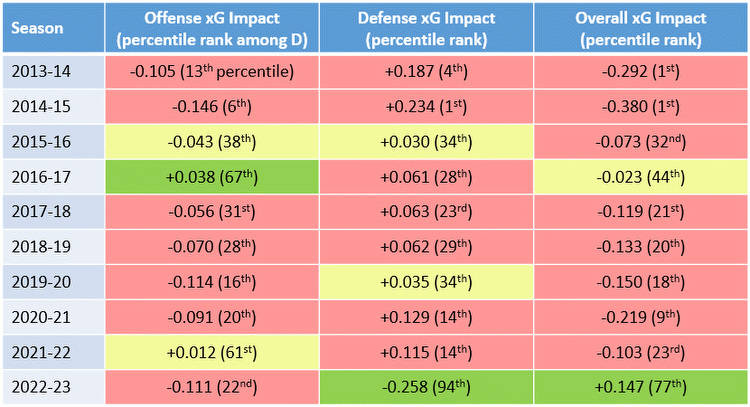
Basically every year of his career, in every category, Rasmus Ristolainen graded out in the bottom third of NHL defensemen at even strength. And then, suddenly, out of nowhere, he grades out like one of the best defensive defensemen in hockey, to the point where he — at long last — had a positive overall impact on his teammates.
Wild.
So what happened? Both Ristolainen and Tortorella acknowledged that at the start of the season, Tortorella rode him hard, especially behind closed doors. Perhaps for the first time, an NHL coaching staff wasn’t blinded by Ristolainen’s undeniable physical traits (he’s big, he can skate well, and he hits everything in sight) and actually recognized that more often than not, Ristolainen wasn’t doing the right things on the ice. Or, at the very least, finally found a way to get that through to Ristolainen — who to his credit, responded to the harsh critiques and made changes.
“It’s pretty simple and clear, and he’s honest,” Ristolainen noted in his exit interview when asked about Tortorella. “I think the way he is and the way he coaches, he probably gets the most out of me. That’s what I appreciate — the honesty good or bad. Sometimes, I need a little push, a kick in the ass.”
Defensively, Ristolainen looked like a new player. No longer was he running around the defensive zone chasing down forwards, selling out for big hits. His hit totals did indeed drop — it was the first time since 2015-16 that he came in below 190 total in that category. Instead, Ristolainen was staying in coverage, using his strength to clear the crease and his reach to, as Tortorella loves to say, “kill plays.”
Take a look at this 10-game rolling-average chart that highlights how many expected goals/60 were being allowed when Ristolainen skated, comparing his work in 2021-22 with the Flyers to his results in 2022-23. The team didn’t get much better as a whole — allowing 2.77 xG/60 in 2021-22 and 2.73 in 2022-23.
But Ristolainen sure did. In fact, his best stretches defensively in 2021-22 are comparable to his worst stretches in 2022-23. That’s how complete the improvement was.
The stylistic changes surely helped. It’s also possible that pulling back on Ristolainen’s responsibilities had an impact as well — which was a long-standing if unprovable theory regarding Ristolainen for years, given the fact that NHL coaches remained obstinate that he should be deployed as a big-minutes, top-four defenseman despite all statistical evidence to the contrary. In 2022-23, Ristolainen spent long stretches on the third pair, and his minutes were down as a whole, to 19 as a per-game average and about 15:30 per night at five-on-five (historically, he was in the 17-19 minute range).
Tortorella tasked Ristolainen with remedial lessons — with a heavy focus on his defensive play — and made him earn his way back up the lineup by showing that he could take instruction from Tortorella and assistant coach Brad Shaw, and add it into his game. That’s exactly what he ultimately did.
“I want him stick-on-puck, being physical, playing under the hash marks the right way. And I think he’s improved tremendously there,” Tortorella noted. “The offense that comes off of that, to me, that’s a bonus.”
The offensive cost
It’s worth noting, however, that Ristolainen’s dramatic defensive improvement didn’t come without a cost.
One aspect of Ristolainen’s resume that always excited coaches and front-office personnel was the fact that he was a mean, big-minutes right-handed blueliner who at the end of the season would also put up 40-plus points. Ristolainen wasn’t just a big physical defenseman — he could make plays with the puck, too. It’s why the Buffalo Sabres dreamed of him for so long as a future No. 1.
Now, Ristolainen’s scoring numbers were always going to come down once the Flyers made the decision in 2021-22 to largely pull him off the power play; Ristolainen racked up a lot of his points in Buffalo on the Jack Eichel-run PP1 there.
But even accounting for the loss of PP time, having only two points in 30 games through the end of December wasn’t going to cut it. Not even the most defense-oriented blueliners are going to be able to get away with scoring at a five-point full-season pace and keep their starting lineup spots for long.
That said, in retrospect, Ristolainen’s extreme scoring issues in the first half of 2022-23 may have been somewhat intentional on the part of the coaches. Now, that’s not to say that the coaching staff actively wanted Ristolainen to avoid scoring. But it does appear that there was a heavy emphasis on fixing his defensive problems first, as part of a full-fledged recalibration of Rasmus Ristolainen. They were so adamant about him addressing those issues that, in the short term, the lack of tangible offense didn’t matter to them. They were playing the long game in terms of development.
“He’s put up some numbers early in his career. Right now, I’m just concerned with him continuing to grow from where he is defensively,” Tortorella noted while Ristolainen was still in the heart of his offensive slump.
The good news is that once the calendar turned to 2023 — really around the middle of January — Ristolainen’s offense came back. Scoring 18 points in 44 games, which was his production from January through the end of the season, really isn’t too shabby for a defense-centric blueliner not getting regular PP time — it’s a decent 33-point pace — and it’s even more impressive if one limits the data set to his final 37 games, since he went scoreless over those first seven January contests. Suddenly, we’re talking about a defenseman on a 40-point pace over the final three months of the season.
That said, his 18 points did come with the help of nine secondary assists, which tend to be far more fickle than primary points. In addition, he graded out in the 22nd percentile by even-strength offensive impact over the full season, so it wasn’t just that he was failing to produce points — he was an overall drag on his team’s offense as well. Turning Ristolainen into a defensive defenseman is almost certainly going to have consequences for his offense.
In 2022-23, however, the gains he made on defense more than made up for it.
Ristolainen moving forward
So is Rasmus Ristolainen fixed? Did the Flyers turn the long-standing advanced-stat whipping boy into an analytical hero?
Well, let’s not get carried away just yet. This was, after all, just one season. Ristolainen has nine years’ worth of poor results that should give one pause before confidently declaring that the 2022-23 version is the real Ristolainen. He still needs to prove that he can hold these gains year over year.
But let’s assume for a second that he can. Just how valuable is this new version of Rasmus Ristolainen?
Here’s a blind comparison test to give you an idea.

So who is Player B, who grades out a bit better than last year’s version of Ristolainen across the board but on the whole is quite comparable? Prime-age Justin Braun in 2015-16, the year he was a rock-solid second-pair defenseman for the San Jose Sharks on their run to the Stanley Cup Final.
The comparison makes sense. Last season, Ristolainen did resemble something of a bigger, stronger and faster version of Braun, who always graded out as legitimately impactful defensively by the numbers but gave back a fair amount of it due to his offensive limitations. Is that a perfect player? Of course not. Is it one who could be a quality piece of a contender’s blue-line corps? Clearly yes.
Now, let’s be clear: At least in the current cap environment, such a player still isn’t worth $5.1 million per year. Dom Luszczyszyn’s model — even after this year’s improvement — projects Ristolainen to be worth $2.6 million per year on average over the rest of his deal. It’s still not a great contract. And even if Ristolainen repeats his results in 2023-24 — Dom’s model penalizes Ristolainen for his poor seasons preceding 2022-23 — it’ll bump up his projection a bit, but likely not enough to justify his full cap hit. Defense-only defensemen just don’t make $5-plus million per year; it won’t be a good contract, in the sense that he’s providing surplus value to the Flyers.
And even this improved version of Ristolainen had his flaws, beyond the offensive trade-offs. He still doesn’t help much in penalty differential. His short-handed chance-suppression metrics didn’t improve along with his even-strength ones. And he still did a lot of his best work in something of a No. 4/5 role, rather than as a nightly top-four lock.
All that being said — this version of Ristolainen is a solid defenseman, and one that falls more in the realm of “acceptable overpay” (especially accounting for the supposed intangible benefits of having a “hard to play against” blueliner) rather than “glaring cap albatross.”
Now, Ristolainen needs to prove that he can hold on to his gains. The safe bet is still on a regression to past career norms — there are nine years of history saying that’s the most likely scenario. But that was the safe bet in 2022-23, too, and Ristolainen beat the odds. Can he do it again? If he does, Rasmus Ristolainen will no longer deserve to be the primary target of ire for any Flyers fans, even those most critical of his acquisition in the first place.
— All statistics courtesy of Evolving-Hockey, Natural Stat Trick and Corey Sznajder.

